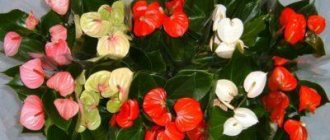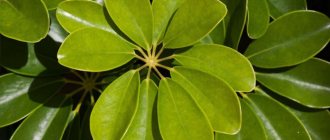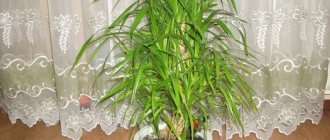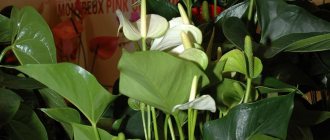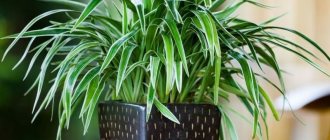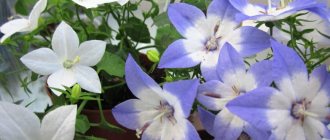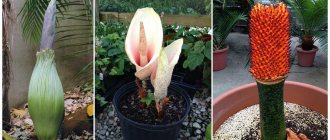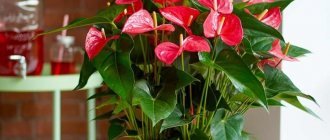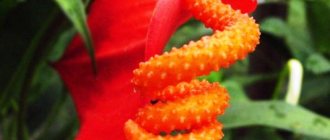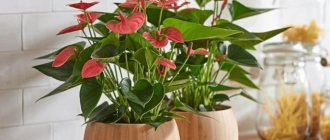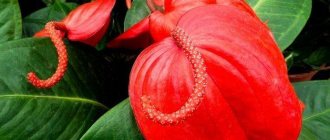How to make men happy? Flowering of homemade Anthuriums!
These natives of the Latin American tropics and subtropics with heart-shaped leaves on long petioles bloom spectacularly in indoor culture - and are believed to thereby provide the surrounding men with a healthy, happy and fulfilling life.
The genus name Anthurium is a composite of the Greek words for “flower” and “tail . Indeed, in about nine hundred species of this genus, the flower itself is shaped like a tail - white or dark, or colored, straight, curved or spirally twisted.
This inflorescence-cob is equipped with a more or less wide leaf-veil of a wide variety of colors and shades - red, white, green, orange, purple.
The odors emitted by flowering anthuriums are no less changeable: from subtle to very strong, from fragrant to fetid - it all depends on which pollinating insects are more often found where a particular type of anthurium grows.
In greenhouse and indoor culture Andre's anthurium and Scherzer's anthurium (including their numerous hybrid forms), beautifully blooming in white-pink-red tones, are most often grown crystal anthurium with discreet flowers that have a delicate pleasant aroma.
Anthurium juice is poisonous and care should be taken when working with them.
How to make Anthurium bloom?
Indoor anthuriums are potentially capable of blooming from February to November , that is, almost all year round, stopping only in the coldest and darkest winter months; in addition, their flowers are unusually durable when cut and remain unchanged for up to four weeks.
For such fabulous flowering, these plants need appropriate conditions, the observance of which requires considerable experience and knowledge.
The main problem is to find a balance of light, temperature, soil and humidity that will remind anthuriums of their native high-mountain tropical forests and they will probably agree to live and reproduce in your apartment.
Creating an appropriate microclimate includes providing lighting - bright but diffuse ; quite long throughout the year.
Temperature
Summer temperatures should be maintained at 20-25 degrees , winter temperatures in the range of 16-18 degrees .
The soil temperature should not be lower than the air temperature, so anthuriums are planted in plastic containers . These containers should not be deep - but not too wide, otherwise they will grow roots and children, not flowers.
Air and soil
Air saturated with water vapor should be fresh - but without drafts.
The soil is moist - but not wet.
Fertilizing is needed - but fertilizer solutions should not be too concentrated.
Compliance with all these “ifs” and “buts” is the main condition for constantly blooming “male happiness.”
And now, finally, your anthurium has blossomed - but it’s too early to calm down. After some time, the bright red blankets turn green, or the rich pink variety turns white, losing its color. This is a normal phenomenon, this is how these plants fade - and the outdated flowers need to be removed .
It also happens that you purchased a luxurious variety with numerous large flowers - but at home it somehow thinned out, crushed and reluctantly forms new inflorescences.
This situation may arise due to the fact that when commercially growing anthuriums in greenhouses, gibberellins, phytohormones that accelerate the growth and overall development of all parts of the plant, are used to improve their presentation.
Care
Water after the soil has completely dried.- Moist air is required.
- There should be no drafts.
- Increase diffused lighting for 12 hours a day. Stretching of leaf petioles and pale coloring indicate a lack of sunlight. In winter, illuminate with LED lamps.
- Plant in a tight pot with nutritious, loose soil so that oxygen can freely penetrate to the roots of the plant.
From the video you will learn how to care for Anthurium:
Anthurium is a flower of extraordinary beauty. This plant will delight and delight its owners throughout the year, subject to all the above recommendations.
How to care for the flower of Male Happiness to bloom?
Deprived of constant stimulation, the specimen gradually returns to its natural state and, if it is provided with proper care, will bloom again - albeit not so brightly and abundantly. Is it possible to replant Anthurium during flowering?
During this period, you need to
feed the plants: once every two weeks , with complex mineral fertilizer.
You can alternate organic and mineral fertilizers, but in any case, the concentration of the solutions should be weaker than the standard one. Anthuriums are species that are quite difficult to grow indoors . Sometimes this plant is given a separate “apartment” - a terrarium, in which, behind glass, they create a real tropical atmosphere for it, providing additional lighting, regulating the temperature, and saturating the air with water vapor. Anthuriums are also grown hydroponically.
However, these “tropicans” can easily grow without any special shelters or tricks.
True, there are interruptions in flowering: the red covers have turned green, you have removed the faded ones - but new flowers are not formed, although winter is still far away and otherwise, judging by its appearance, the plant feels good.
Sometimes a young specimen does not bloom or a transplanted anthurium grows but does not bloom.
All these problems have their own causes that can be eliminated.
If you wait and do not wait for the flowering of a specimen grown from seeds, remember:
If, as expected, in the interval between flowering, and not during it, you transplanted the anthurium into a new, expanded container - it may turn out to be too wide and flowering will not begin until the container is filled with roots and children. For flowering you need a small pot . You will find more information about planting and replanting anthurium here.
Why doesn't Anthurium bloom at home? Check that all conditions for proper care are met:
- The soil should be suitable for epiphytes - plants with aerial roots: loose, fibrous, moisture- and breathable, well-drained, ideally - special soil for orchids.
- Watering – ensures a constantly moist, but not stagnantly damp condition of the soil. The water is soft, its excess is immediately drained from the pan.
- Air humidity is significantly increased: you can add wet sphagnum on a tray to frequent spraying. Aerial roots are also covered with this moss.
- Fertilizing - twice a month, with a diluted solution of complex fertilizers.
- Temperature - during the flowering season not lower than 22 degrees (stimulates the development of buds), in winter - from 16 to 18 degrees (stimulates the formation of buds).
- The lighting is bright and at the same time diffused: a western or eastern window, supplementary lighting during short daylight hours.
If all these conditions are present, the anthurium is not too young, is not busy growing roots and forming children - and still does not bloom, you can try to stimulate it further .
To do this, in the spring, water the plant with soft water at a temperature of 40-50 degrees.
Some people pour water heated to 60 degrees into a pan once a week and leave it there until it cools, then drain it. The atmosphere of a warm steam room helps the anthurium to finally awaken to a full-blooded life.
Abundant, regular, exotic flowering of anthurium can be considered a successfully passed exam for the title of a diligent and skillful florist, and the happiness that should cover all domestic men, apparently, defies description.
Next you will see a photo of Anthurium blooming:
How to propagate.
Red King
- Reproduction. Anthurium lends itself quite well to propagation in all possible ways. And there are several of these methods. The simplest and most popular is dividing the bush when planting or replanting. To do this, you need to free the plant from the container where it grew. Next, carefully straighten the roots and clean them of soil and old roots. Find several shoots or shoots and divide them. Next, we plant them in separate pots and care for them as usual.
Cuttings - this method allows you to take cuttings from a long shoot. This is especially true if your anthurium has stretched out. Or the plant needs to be rejuvenated. We try to cut the cuttings so that there are aerial roots on the lower part of the shoot.
Offshoots are young shoots that grow next to the main mother bush. They can be carefully separated and planted separately.
Layering - for this you need to select the desired shoot and bend it so that part of the shoot with roots can be rooted in a separate pot. After some time, the shoot can be cut off and the rooted plant can be placed in a permanent place.
Propagation by seeds is a longer process. To do this, you need to let the seeds ripen. This means not cutting off the peduncle after it wilts. As soon as the seeds are ripe, they will need to be collected and dried. Particular attention is paid to the seeds remaining viable for about a month.
Next, we sow them in a separate container. And it is necessary to create special conditions for growing. Maintain humidity and temperature above 25 degrees. As soon as the seeds germinate, you can remove the shelter (and in order for them to germinate, they need greenhouse conditions. We are building a greenhouse for germinating anthurium seeds). As soon as the seedlings get stronger, they can be planted in separate containers. To germinate seeds, it is better to use peat tablets. When transplanting seedlings grown in peat tablets, the roots will be minimally damaged.
As for propagation by leaves, this is due to the structural features of the anthurium leaf. This process is quite difficult. Choose the best reproduction method for yourself. Read about reproduction HERE.
How anthurium blooms, how many times, signs of flowering
Anthurium is popularly called the flamingo flower and men's happiness. The plant is given to men and young couples as a symbol of male strength and the ability to stand up for their family.
Features of anthurium flower
The name of the plant is made up of two ancient Greek words - flower and tail. But according to botanists, that part of the plant that looks like a flower is actually a colored leaf, a blanket. In nature it is green or white, but as a result of hybridization, varieties with brightly colored perianths have been developed: orange, pink, burgundy, purple.
Anthurium flowers consist of a perianth and a spadix
The anthurium flower itself is the so-called tail or spadix. It also comes in different colors (white, green, yellow, purple). In addition, the "tail" can be straight, spiral, or curved like a bird's neck.
Anthurium flowers with curved inflorescences are very similar to flamingo birds
The inflorescence itself is also complex; it consists of many small flowers in the shape of diamonds or squares. Moreover, anthurium has two flowering phases: female and male. In the female phase, the flower extends its pistil, and on its stigma you can see a drop of sweet liquid, attractive to pollinators. As soon as this droplet dries, the stamens with pollen move forward. Sometimes they are visible for several hours and then retract, revealing the pistil again. There are varieties in which both male (in the upper part) and female flowers (in the lower part of the inflorescence) are located on the cob. After pollination, berries with seeds are formed and distributed by birds.
Anthurium fruits that form after flowering
There are no blue or blue anthuriums in nature, but they are sold in stores and even have the spectacular name Alexia Blue. Breeders claim that anthurium does not have a blue pigment, so it is impossible to breed such a flower. Sellers simply add ink dye to the irrigation water. In this case, not only the flowers, but also the veins on the leaves can turn blue; the leaves themselves often have a dirty green color. You can buy such anthuriums; they will grow at home, but will lose their spectacular color. White anthuriums are most often painted; it is easiest to give them an unnatural color.
Blue anthurium at home will very soon turn white
Duration of anthurium flowering
Wild species bloom from several hours to several weeks. And on the windowsills of home gardeners, anthurium can bloom continuously. But there are varieties that bloom in the spring, and the flower lasts until mid-autumn. Other varieties, on the contrary, put out flower stalks in the fall and bloom until spring. Anthuriums have also been bred that do not bloom at all or are distinguished by modest, short-lived flowering, but have very beautiful leaves.
Anthurium with decorative leaves usually has inconspicuous flowers
How to understand that anthurium will bloom soon
Anthuriums ideally extend a peduncle from the axil of each leaf. This plant very actively forms root children, so flowers of different sizes may appear in one pot: large in the mother’s pot, smaller in the children’s. If you carefully monitor the anthurium, you will notice how arrows periodically appear from its base. The green arrow is a leaf, and the red arrow is a long-awaited bud.
The first to appear is the rolled up perianth (veil). Then the stem (peduncle) grows and raises the bud above the leaves. After this, the blanket unfolds, revealing the inflorescence.
Reproduction
Cuttings are the easiest and most effective way to propagate clerodendrum.
In the spring, young shoots are cut from the plant and planted in a mixture of sand and peat, covered with glass or plastic film and set up in a small greenhouse.
Recently, flower shops have been selling ready-made greenhouses and greenhouses - they are very convenient and will last for many years.
Calla lilies and Spathiphyllium are very similar to red anthurium, whose beautiful green leaves turn white during flowering. The modest, delicate spathiphyllum and its picturesque antipode, anthurium, look great together.
Anthurium Amaretti has a white inflorescence with red spots . The blanket contains different colors:
- red;
- orange;
- yellow.
green;
The compact Anthurium Andrianum Edison has wide, rich green, heart-shaped leaves. It has tall peduncles that rise above the bush. A round leathery blanket surrounds a yellow or white cob.
The low Anthurium Nano Red forms a spreading bush with small growing points . It has pointed dark green leaves. The peduncle is straight, rising above the bush. The upright cob has a reddish-orange hue. The color of the small heart-shaped blanket ranges from reddish-green to crimson.
Caring for blooming anthurium
Blooming anthurium comes to us from the store, often as a gift. So that it does not die and pleases the donor and owner, you need to change the pot and soil. Indoor flowers are sold in soil that has no nutritional value. This is just a damp substrate in which the plant will not survive for long. You need to replant after about two weeks, without waiting for the end of flowering.
What should the pot be like for the anthurium to continue to bloom?
It is recommended to choose a plastic pot and not too deep. Clay allows moisture and air to pass through the pores, it is blown, and in winter the roots in such a container can freeze on the window. You cannot take a pot much larger than the one in which the anthurium grows. If you insert an old pot into a new one, there should be 1–2 cm between the walls, but no more. Having received space and nutrition, the flower will literally go to the root and will not bloom until it becomes cramped again.
Along with the pot, you can also buy a flowerpot. The pot is placed in a flowerpot, and the gaps between their walls are filled with moss, which must be constantly kept moist. Anthurium loves moist air, especially in winter, during the heating period.
Soil for flowering anthurium
The main condition for soil is looseness. If it is not followed, the plant will stop blooming and may get sick.
Under natural conditions, anthurium grows on leaf litter with the remains of rotten wood, so it won’t really like it in ordinary soil.
The store does not sell ready-made soil specifically for anthurium; it is suitable for azaleas, violets, orchids or for flowering indoor plants with an acidity pH of 5.5–6.5. Coarse fractions (at least 10%) must be added to the purchased soil: sphagnum, bark, small pine cones, charcoal. You can make up the soil mixture yourself: mix 2 parts humus, 1 part sand, 1 part peat, dry semi-ripe leaves, charcoal in pieces of different sizes and bark. The prepared soil must be sterilized (calcined in the oven).
Lighting and temperature
Proper home care for anthurium involves, first of all, creating a comfortable level of light and temperature.
It is advisable to keep the flower pot away from the radiator: dry hot air is detrimental to the plant. In winter, anthurium can survive a drop in temperature to +16-17 °C - the most dangerous thing for it is not even the cold, but drafts. The most comfortable room temperature for this plant varies in the range of +20-25°C.
In nature, anthuriums grow in the shade of large trees and prefer bright, diffused light. Direct sunlight can cause leaf burns . If there is a lack of light, the leaves of the anthurium acquire a yellowish tint, and the plant may stop blooming.
Secrets
Since anthurium is an epiphytic plant, like an orchid, and has aerial roots, it cannot be planted directly in universal soil, as this causes rotting of the root system and death of the entire flower.
The soil plays the most important role in the process of organizing conditions for year-round flowering of anthurium.
To ensure long life and abundant flowering, it is important to choose the right substrate in which the roots will feel comfortable.
It is recommended to purchase soil for orchids at a specialized store, but you can make it yourself by mixing high-quality charcoal, which serves as a base, as well as fallen leaves and pine bark, which are rich in nutrients.
Most of the mixture should be bark, which should be chopped into medium-sized pieces. You need to add light coniferous and leaf soil to it and mix thoroughly. The soil should be lush, easily permeable to moisture, which the plant also needs. Therefore, you need to add good wood ash to the mixture - not too fine, but not turned into powder. This part should not exceed 10% of the total volume of the substrate.
It is important to monitor the acidity of the soil - it should be slightly above average. In such conditions, epiphytes feel most comfortable.
Pots for these flowers should be small, since in large containers the root system develops too slowly, which negatively affects the set of green mass and the budding process.
It is necessary to provide good drainage in the pot to avoid stagnation of water. After planting the flower, it is recommended to cover the soil with large pieces of pine bark, which will maintain the required level of humidity and saturate the substrate with nutrients.
Watering is no less important for the constant flowering of this epiphyte than the composition of the soil. It is advisable to carry out the procedure regularly, without allowing the earthen clod to dry out too much. However, the amount of water should be moderate, since its excess can cause rotting of the root system. It is better to water the plant with settled water at room temperature. You can sometimes add a few drops of lemon juice to it.
Anthurium: what to do to make it bloom
On the South American continent, it is believed that the aroid perennial grows even when simply thrown onto the ground, without any care - anthurium blooms there in any case. This is the only way a tropical resident behaves in natural conditions, that is, in subtropical and tropical climates. There are favorable conditions for the development of anthurium and the production of bright inflorescences. But in cases where “women’s happiness” grows on a windowsill in a room in an average climate, anthurium at home may not bloom at all.
Types of indoor anthuriums with photos
Anthurium Andreanum
This type of Anthurium is the most common in home gardening and is valued for its year-round flowering.
The leaves of the plant are shaped like a large heart, dark emerald in color and sit impressively on tall petioles. Dense, fleshy stems cover aerial roots.
The flower is an even ear, shrouded in a petal-veil of white and even green color. These colors are not the limit; Anthurium Andre can delight the owner with yellow, red, pink and other colors.
Anthurium Scherzerianum
This species belongs to the epiphytes. It has low stems of 30-40 centimeters in height.
The leaves are an elongated oval, matte green, strewn with small black spots over the entire surface. Peduncle higher than foliage. The flower itself consists of a thin spadix, twisted into a “pigtail” and covered with a solid matte scarlet petal.
The color and shape of the flower have given Scherzer's Anthurium the nickname "flamingo flower".
Anthurium Crystallinum
Crystal Anthurium is grown as a foliage plant due to the beauty of its leaves.
The leaf plate is heart-shaped and 40 centimeters long. The leaves have a green color with a purple tint, and against this background the silver veins stand out brightly.
The flowers are small, even cobs, with a blanket of light green or pale purple flowers.
Anthurium Magnificent (Excellent, Majestic) / Anthurium Magnificum
At home, this type of Anthurium has taken root due to its decorative foliage. The large leaves have a velvety texture. Their color is dark green. The surface of the leaf plate is cut with white lines.
Reasons why anthurium does not bloom
This perennial is called not only “women’s happiness,” but also “the flower of love.” Its beautiful flowers are distinguished by shades of red, white, burgundy or pink, as well as the striking oblong shape of the foliage. Although it often happens that the “flower of love”, which has bloomed many times already, does not bloom for a long time. There are many reasons for this phenomenon.
“Women's happiness” loves comfort, regular watering and good care. If the plant is placed in a room where the temperature and humidity conditions are not suitable for it, it will not only not bloom, but may even perish. This plant is a capricious plant. Anthurium blooms even in comfort worse than in its homeland. The article describes some reasons why a plant “does not want” to bloom and ways to “force” it to produce flower stalks.
Incorrect lighting
Anthurium is a light-loving indoor flower, but still prefers diffused sunlight, which should illuminate the plant for as long as possible. Therefore, the flower must be placed on a windowsill, which is located under a window facing east or west, placing it closer to the glass. Inexperienced anthurium lovers often place the flower in bright sun, believing that this way it will bloom faster. After all, he comes from the sunny tropics. Others, seeing that a plant on a sunny windowsill does not put out flower stalks, move it to a dimly lit room. But the plant does not bloom in such conditions at all. Bright sun can cause burns of leaves and flowers, and a semi-dark existence will not lead to the development of flower shoots. Anthurium blooms under certain lighting conditions.
Incorrect watering mode
It is better to water “female happiness” moderately, with soft water, which is left in the room for about 5 days. On hot summer days, it is necessary to spray it twice a day and wipe the leaves every seven days, removing dust from the leaves. In winter, the water should be a little cooler than in warm weather; you can also water the perennial with filtered water. How much water should I pour into the pot? The soil should not be waterlogged. If the top layer in the pot is kept too wet or constantly dried out, then this “flower of love” will not bloom even in excellent lighting and comfortable conditions.
Water the perennial so that water does not fall on the glossy surface of the green leaves. If drops remain there, the leaves will begin to darken. The soil in the pot should always be moist. The air should also have high humidity. Where the anthurium “came” from, there are constant showers. For this reason, the watering regime is the most important for the plant. Then the anthurium blooms profusely.
- for irrigation, use only settled water without any additives or impurities;
- watering the soil should be plentiful, but stagnation of water is unacceptable either in the pot or in the pan;
- the temperature of the water for irrigation should be at room temperature;
- every day, morning and evening, the anthurium is sprayed with a spray bottle;
- when the plant is placed on a windowsill above a heating radiator, vessels with water should be placed nearby to increase the humidity level;
- Excess water in the ground causes rotting of the root system, and if there is insufficient moisture, the leaves dry out.
Unfortunately, it is impossible to create complete comfort for a perennial. Where the “flower of love” grows, the air humidity is almost 100%, thanks to the constant fog. This is impossible in indoor or greenhouse conditions.
Temperature
The capricious anthurium feels comfortable in winter in indoor conditions. During normal operation of the radiator heating, the temperature regime of +20° C is most suitable for perennials. And if it’s hot, the flowers won’t set. It is best if there is an air conditioner operating near the ceiling in the room to regulate the temperature.
Wrong soil
It happens that the soil is chosen incorrectly, this is the reason the plant refuses to produce flower arrows. Peat, for example, is not suitable for perennials; its roots prefer humus and good drainage. It is also a mistake to plant the plant in soil that is intended for succulents or palm trees. The most suitable soil for “female happiness” is soil for orchids, which consists of humus mixed with charcoal, particles of bark and moss (sphagnum). When peat is added to the soil mixture, the plant will refuse to bloom.
Incorrect feeding
Regular fertilizing with acid-type fertilizers can help the tropical guest bloom. Such fertilizing is done no more than once a month, using liquid fertilizers. You can also add pine needles to increase acidity. Calcium should not be present in such fertilizers; its excess causes rotting of the roots.
Errors during transplantation
Anthuriums also need to be replanted correctly. Otherwise it will never bloom. This requires the correct selection of soil and pot size. Damage to the roots during transplantation can even lead to the death of the flower. The small container is periodically replaced with a larger one. This is done to prevent roots from growing through the holes in the bottom. A pot that is too wide or high is also unacceptable. It should be 2-3 centimeters wider than the previous one, and approximately the same in height. There should be enough soil in the pot so that the roots are completely hidden by it.
Other reasons
Inexperienced gardeners are surprised when a gift of a flowering indoor anthurium stops flowering after some time, although all care errors have been corrected. There are several other reasons for this:
- stems or roots are affected by disease or pests;
- frequent rearrangement of perennials from one lighting level to another;
- the flower pot is located in a draft;
- low air temperature also does not contribute to the development of flower buds on the stems;
- a lack of fertilizer or its excess often leads not only to the fact that the plant does not bloom, but also to its death;
- The flower stalks are left on the stem after flowering and must be removed to the base.
Reproduction of spathiphyllum
Reproduction occurs by dividing the bush and seeds. It is very convenient to perform this procedure during transplantation. You need to divide the plant very carefully so as not to damage anything, otherwise the cuttings will not take root.
Seeds
A rather advantageous feature of red spathiphyllum is that it can be grown from seeds. However, in order for them to form, it will be necessary to take care of this initially.
It is necessary to carry out the process of pollination of flowers. It involves the transfer of pollen from one flower to another. To perform this operation, you will need a swab with a cotton tip or a brush with a certain softness. Pollination manipulations should be repeated several times over several days. Patient housewives will wait for the formation of colorful berries 10-11 months after the operation. However, in this matter you should still be patient until the seeds form.
To do this, the seeds need to be removed from the berries and washed under running water. Then you should make a 0.1% solution of potassium permanganate. Seeds are sent into it to prevent mold from growing on them. They should remain in the solution for 2 hours.
Since the seeds lose their ability to germinate within a short time, they must be sent to a shallow container, the bottom of which is covered with slightly damp foam rubber. The top of the vessel should be covered with a plastic bag or glass lid. After germination, the seeds need to be planted. This procedure must be performed 3 or 4 times. Picking is done in a high-quality soil mixture. Seedlings should be placed at a distance of 1.5 cm from each other each time.
After the seedling reaches 7-8 cm, you need to transplant it one last time. A vessel with a volume of 0.2 liters will be suitable for the flower. With proper care, the seedling will begin to actively grow and will require another transplant in 11-12 months.
Dividing the bush
The resulting cuttings should not have wilted leaves: they should be cut off immediately. If there are no roots when dividing, then the plant should be placed in water for 3 weeks and wait until it takes root. The length of the roots should be at least 2-3 cm, then the plant can be planted in the soil. If you do not need the plant to grow too much, then on the division you need to leave one growth point and a rhizome.
It is better to divide at a warm air temperature: +20-21 °C.
Make sure that each rhizome has several leaves: at least 2-3. The delenka needs to be planted in a pot whose diameter will be 15 cm, no more. The pot must first be filled with the substrate described above. Carefully observe all proportions. Some gardeners also recommend the following substrate: leaf soil, coniferous soil, a layer of humus, peat and sand. The ratio is as follows: 2:2:2:2:1.
Why did anthurium stop blooming?
It happens that anthurium blooms magnificently, and then stops flowering and new foliage does not appear.
First of all, the plant needs to be replanted. A flower bought in a store especially needs this. Indoor flowers arrive on store shelves in shipping containers with a small amount of peat, fertilizers and chemicals. The supply of these funds is designed for a month - two flowerings. But at this time there is no development of roots and foliage. If the plant is not replanted in time, it will become exhausted and die.
After this, the anthurium needs some period to strengthen the roots and ground parts. Often this period extends for several months. Sometimes pets that were pleasing to the eye with lush inflorescences stop blooming. In these cases, the method used in industrial greenhouses or conservatories is often used. For this purpose, from late autumn the plant is placed in a well-lit room where the temperature is maintained from 16° C to 20° C. If necessary, artificial lighting can be added.
“Women's happiness” is watered regularly, but not as abundantly as in the summer. Then, after a couple of months, when new stems and leaves appear on the ground part of the bush, it needs to be moved to a warmer room and watering increased. The most comfortable temperature will be around 23° C.
If the plant has not yet bloomed, it will definitely send out peduncles. Anthurium blooms in the spring and this period lasts a long time: about one and a half to two months, if you remember to follow the rules of flower care.
Young anthurium
If the new plant is a young representative of an exotic flora that previously could not please its owners with inflorescences, it needs help.
The saving method will be the one used in greenhouses:
- Place the plant in a pot in a bright room in which the temperature does not rise above plus 20 degrees Celsius;
- The soil must be watered so that it is uniformly moist every day;
- After 45 - 60 days, the crown should be covered with new shoots, this is the right time to transfer the anthurium to heat;
- During spring active growth and development, watering should be increased in anticipation of the first flower stalk.
If all the above conditions are provided, you can enjoy anthurium flowers for as long as 6 – 8 weeks. This is the very bonus for the time and effort spent.
Diseases
Failure of a plant to produce flower stalks often results in disease.
- Sometimes dark spots appear on the surface of the leaves. The reason for their appearance is that the temperature in the room is too low. Essentially the plant freezes.
- Infections often affect all parts of the “flower of love.” Anthurium can be infected by viruses and microorganisms. There is no countermeasure against them yet, and therefore such diseases lead to the death of the bush.
- Some infections can be treated with chemicals sold in stores. For example, in some cases you can get rid of the infection with potassium permanganate or Glyokladin.
- Fungal diseases are treated with fungicides. But this is only possible with timely treatment.
Pests
The most common insects that like to settle on anthurium are:
- aphid;
- thrips with scale insects;
- spider mites;
- root nematode.
These insects, being parasites, suck juice from any parts of the flower, depriving them of nutrition. Signs of the appearance of insect pests can be determined during hygiene procedures regularly carried out during care.
Why anthurium does not bloom at home: how to find an approach to an exotic plant
White anthurium and other species: cultivation, reproduction, diseases
Anthuriums - conditions of detention, care, reproduction
How to grow and propagate anthurium at home
Pests and diseases.
Diamond dir
- Pests. They can cause severe damage to your flowers. Therefore, you should regularly inspect plants for pests. Spider mites, scale insects, and many other pests will cause quite a lot of trouble. Prevention and early treatment with special drugs will be beneficial. - Diseases. Diseases can be viral or fungal. The main problem is root rotting. When the soil is waterlogged, many problems can arise. If the disease is started, the plant dies and cannot be saved.
When does anthurium bloom at home?
The flower “male happiness” or the flamingo plant – people give anthurium different names, but this does not change the characteristics of the plant. The timing of flowering is strictly determined by the development cycle of anthurium. How often and for how long should your anthurium bloom at home?
When does anthurium bloom at home : from early spring to autumn, but most only in winter. Anthurium Andre, for example, is a plant with constant flowering.
How long does anthurium bloom : up to 3-4 weeks with the most comfortable care. We will look at where to place anthurium to bloom longer in the second part of this article.
Feeding and fertilizers
During active growth and flowering (mid-March - mid-September), feed the anthurium at home every 3-4 weeks.
Feeding will stimulate active development, abundant and long-lasting flowering. The rest of the time there is no need for additional nutrients, but some experts advise feeding in the fall and winter once every 4-5 weeks to maintain strength.
Fertilizers
Add universal fertilizers for flowering indoor plants to the water for irrigation. You can also use complex mineral fertilizers. The main thing is to feed 20-50% of the indicated dose (the flower is sensitive to an excess of mineral salts).
The names of the fertilizers are similar: for flowering species or for roses, begonias, orchids, azaleas and rhododendrons, primroses and violets, since the composition and concentration are approximately the same.
The only difference is “Bonaforte”, “Compo”, “Fertika”, “Greenworld”, “Plantella”, “Pokon”, “Agricola”, “Baikal”, “Windsor”, “Living Force”, “Kemira-lux”, “Rainbow”, “Uniflor-bud”, “Flower Paradise” and others.
- Some gardeners like to use Ideal fertilizer (nitrogen, potassium, phosphorus + humic acids, 250 ml costs about a dollar) with a wide spectrum of action and a large number of macro- and microelements.
- And some experts prefer to feed “male happiness” with long-acting granules (for example, “Augustina”, etc.), which can be easily placed in the ground during transplantation.
Is it possible to feed orchid fertilizer?
Fertilizers for orchids (“Bona Forte” is the recommended dose) are also suitable for use.
Organic fertilizers
It is better to alternate fertilizing with liquid mineral fertilizers with organic substances. Many sources recommend using infusions of mullein (1:10) or chicken manure (1:15) as an organic fertilizer, but for indoor flowers it is better to use vermicompost (we talked about it in detail in the article about types of fertilizers).
Rules
- First, water the flower a little with soft water, and then with a solution of fertilizers, so as not to burn the root system.
- After transplantation, you can feed Andre, Khrustalny and Scherzer anthuriums no earlier than a month later, or even two, depending on the composition of the soil.
WE RECOMMEND READING:
- TYPES OF FERTILIZERS FOR HOUSE FLOWERS - REVIEW!
- NATURAL HOME FERTILIZERS – TOP 20 FEEDINGS!
Why doesn't anthurium bloom at home?
Different types of anthurium allow you to choose a variety with flowering to suit your schedule, but the plant is extremely capricious and can go on strike, not wanting to form buds. This turn of events can only be prevented by proper care. What kind of care is wrong?
Why does anthurium not bloom at home:
- The soil is not sufficiently moistened;
- Frequent flower rearrangements;
- Anthurium is in a draft;
- Little sunlight;
Anthurium flowering continues for several weeks if the apartment is moderately warm and has access to sun and moisture. By placing male happiness on the windowsill in the spring, you can achieve longer flowering. In winter, make sure that the anthurium does not stand in the shade or in a draft, and also check the soil in the pot - it should be constantly moist and dry out a little a day before the next moistening. Try to move the anthurium as little as possible - it is one of those plants that do not like rearrangements (ficus too).
Anthuriums of hybrid varieties were bred for modest but unusual flowering, so your representative of the Madagascar plant may be among them and delight with inflorescences for a very short time. Remember what variety you were told when purchasing and write in the comments to learn more about its cultivation rules and flowering period.
Caring for men's happiness after purchase
You need to think about care at home in advance so that there are no problems after the purchase.
Male happiness, tempting photos of which can be found on the Internet, is demanding in terms of care: lack of moisture, as well as its excess, poor lighting, incorrect temperature conditions, drafts can not only slow down growth, interrupt flowering, but even completely destroy the pet.
It is no secret that the conditions for keeping sprouts for sale in stores are not always optimal. The main task of trade is sale; after purchase, the florist may encounter signs of wilting. For example, leaves begin to turn yellow or black, turgor decreases, and flowering stops. To find out what you will encounter, immediately after purchase you need to observe the plant for several days.
The mistake of many novice gardeners is transplanting a red flower into a new flowerpot immediately after purchase.
If necessary, this procedure can be carried out in a few days; for the first three to four days, it is enough to just spray the leaves and soil with a spray bottle, thus combining adaptation and quarantine.
